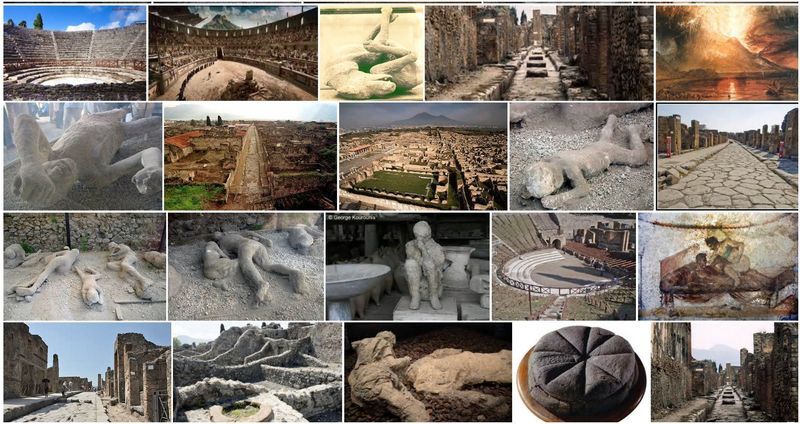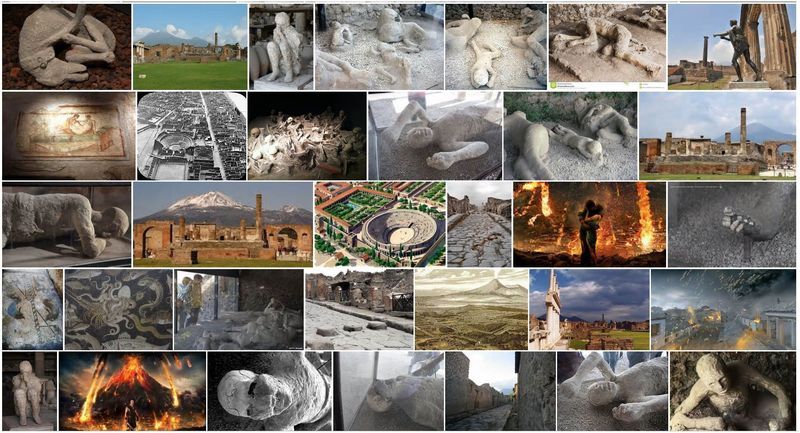Skip to comments.
The Fall and Rise and Fall of Pompeii
Smithsonian Magazine ^
| July 2015
| Joshua Hammer
Posted on 07/01/2015 5:37:25 PM PDT by SunkenCiv
...The two towns remained largely undisturbed, lost to history, through the rise of Byzantium, the Middle Ages and the Renaissance. In 1738, Maria Amalia Christine, a nobleman's daughter from Saxony, wed Charles of Bourbon, the King of Naples, and became entranced by classical sculptures displayed in the garden of the royal palace in Naples. A French prince digging in the vicinity of his villa on Mount Vesuvius had discovered the antiquities nearly 30 years earlier, but had never conducted a systematic excavation. So Charles dispatched teams of laborers and engineers equipped with tools and blasting powder to the site of the original dig to hunt more treasures for his queen. For months, they tunneled through 60 feet of rock-hard lava, unearthing painted columns, sculptures of Roman figures draped in togas, the bronze torso of a horse -- and a flight of stairs. Not far from the staircase they came to an inscription, "Theatrum Herculanense." They had uncovered a Roman-era town, Herculaneum.
Digging began in Pompeii ten years later. Workers burrowed far more easily through the softer deposits of pumice and ash, unearthing streets, villas, frescoes, mosaics and the remains of the dead. "Stretched out full-length on the floor was a skeleton," C.W. Ceram writes in Gods, Graves and Scholars: The Story of Archaeology, a definitive account of the excavations, "with gold and silver coins that had rolled out of bony hands still seeking, it seemed, to clutch them fast."
In the 1860s a pioneering Italian archaeologist at Pompeii, Giuseppe Fiorelli, poured liquid plaster into the cavities in the solidified ash created by the decomposing flesh, creating perfect casts of Pompeii's victims at the moment of their deaths -- down to the folds in their togas, the straps of their sandals, their agonized facial expressions.
(Excerpt) Read more at smithsonianmag.com ...
TOPICS: History; Science; Travel
KEYWORDS: ancientautopsies; godsgravesglyphs; herculaneum; italy; pompeii; romanempire; vesuvius
Navigation: use the links below to view more comments.
first 1-20, 21-40, 41-54 next last
subtitle, "The famous archaeological treasure is falling into scandalous decline, even as its sister city Herculaneum is rising from the ashes".
Doomed by proximity to Vesuvius, the two cities of Pompeii and Herculaneum were entombed within a day. Accounts at the time documented the spread of the ash cloud beyond Rome, as far as Egypt and Syria. (Guilbert Gates)

1
posted on
07/01/2015 5:37:25 PM PDT
by
SunkenCiv
To: StayAt HomeMother; Ernest_at_the_Beach; decimon; 1010RD; 21twelve; 24Karet; 2ndDivisionVet; ...
A bunch of really nice photos, haven't finished the text but hit no teeth-jarring stupidity (like, "the eruption, were it to happen today, would be exacerbated by global warming"). The restoration of Neptune and Amphitrite is magnificent.

2
posted on
07/01/2015 5:39:18 PM PDT
by
SunkenCiv
(What do we want? REGIME CHANGE! When do we want it? NOW)
To: SunkenCiv
Had the good fortune to have visited there this past April. The place is absolutely fascinating.
3
posted on
07/01/2015 5:39:19 PM PDT
by
cld51860
(Volo pro veritas)
To: SunkenCiv
You are busy today!
Thanks for all your posts.
FMCDH(BITS)
4
posted on
07/01/2015 5:40:21 PM PDT
by
nothingnew
(Hemmer and MacCullum are the worst on FNC)
To: nothingnew
My pleasure, and thanks for the kind remarks!
5
posted on
07/01/2015 5:45:12 PM PDT
by
SunkenCiv
(What do we want? REGIME CHANGE! When do we want it? NOW)
To: cld51860
That was good fortune. I’m glad something’s getting done, the complaints about the state of Pompeii have gone on for decades. There have been odd problems, like tourists picking up statues and carrying them right on out through holes in the fence, nighttime vandalism by the local gentry, public urination on ancient walls, just wonderful stuff.
OTOH, the place was buried by a volcanic eruption and unmaintained in any fashion for 17 centuries prior to discovery, so, we probably should cut the place some slack. The main reason Pompeii remains in large part unexcavated is that the already exposed parts were having this problems. There’s probably some real amazing stuff yet to be found under the soil, and none of us will ever get to see it, live or in photo.
6
posted on
07/01/2015 5:48:58 PM PDT
by
SunkenCiv
(What do we want? REGIME CHANGE! When do we want it? NOW)
To: SunkenCiv
I wonder if some day, Naples will be covered with ash. I guess with modern volcano monitoring they will be able to leave but still it would be a catastrophe.
7
posted on
07/01/2015 5:50:02 PM PDT
by
yarddog
(Romans 8:38-39, For I am persuaded.)
To: yarddog
8
posted on
07/01/2015 6:28:28 PM PDT
by
SunkenCiv
(What do we want? REGIME CHANGE! When do we want it? NOW)
To: cld51860
Four years of Latin, two years of Roman Humanities: I have to go!
9
posted on
07/01/2015 6:29:34 PM PDT
by
Mikey_1962
(Democrats have destroyed more cities than Godzilla)
To: cld51860
I’d like to go there some day myself. How much time would you suggest to see it adequately?
To: SunkenCiv
11
posted on
07/01/2015 6:37:04 PM PDT
by
ETL
(ALL (most?) of the Obama-commie connections at my FR Home page: http://www.freerepublic.com/~etl/)
To: SunkenCiv
I was stationed in Naples, Italy from 1981 to 1984, USAF officer working at the NATO base there. I had the awesome opportunity to go to Herculaneum many times and I would sit for hours watching the archiologists as they uncovered the ruins. I also went to Pompei many times, it was in good shape and nothing was closed at that time. It was unbelieveable to see the intricacy of the spas and statues and the layout of the city. Just fascinating.
13
posted on
07/01/2015 6:43:37 PM PDT
by
SunkenCiv
(What do we want? REGIME CHANGE! When do we want it? NOW)
To: yarddog
whoops, sorry, the NOLA keyword includes hundreds of topics about New Orleans. Here are the relevant ones:
14
posted on
07/01/2015 6:44:49 PM PDT
by
SunkenCiv
(What do we want? REGIME CHANGE! When do we want it? NOW)
To: Controlling Legal Authority
I went to Pompeii, it is in really bad shape. Dead people all over the place. Over run with tourists too.
15
posted on
07/01/2015 6:45:29 PM PDT
by
central_va
(I won't be reconstructed and I do not give a damn.)
To: ETL
Top row, middle photo: poor doggie.
16
posted on
07/01/2015 6:45:43 PM PDT
by
tumblindice
(America's founding fathers: all armed conservatives.)
To: ImNotLying
Nice! As you know, the Herculaneum site is actually better preserved, including a number of upper storeys, and lots of carbonized wood, including doors which still swing on their hinges. At an early time, the diggers noticed that the stone was lousy with tiny pores still filled with poison gases, making digging there a little challenging. :’)
17
posted on
07/01/2015 6:47:12 PM PDT
by
SunkenCiv
(What do we want? REGIME CHANGE! When do we want it? NOW)
To: ETL
18
posted on
07/01/2015 6:47:25 PM PDT
by
SunkenCiv
(What do we want? REGIME CHANGE! When do we want it? NOW)
To: SunkenCiv
ETL’s photos, fourth row down, four across: bread?
19
posted on
07/01/2015 6:50:12 PM PDT
by
tumblindice
(America's founding fathers: all armed conservatives.)
To: tumblindice
Yeah, there were a couple of place at least where bread was preserved, still in the ovens. Modestus was the baker’s name on the larger, better known bakery. :’)
20
posted on
07/01/2015 6:52:41 PM PDT
by
SunkenCiv
(What do we want? REGIME CHANGE! When do we want it? NOW)
Navigation: use the links below to view more comments.
first 1-20, 21-40, 41-54 next last
Disclaimer:
Opinions posted on Free Republic are those of the individual
posters and do not necessarily represent the opinion of Free Republic or its
management. All materials posted herein are protected by copyright law and the
exemption for fair use of copyrighted works.
FreeRepublic.com is powered by software copyright 2000-2008 John Robinson



